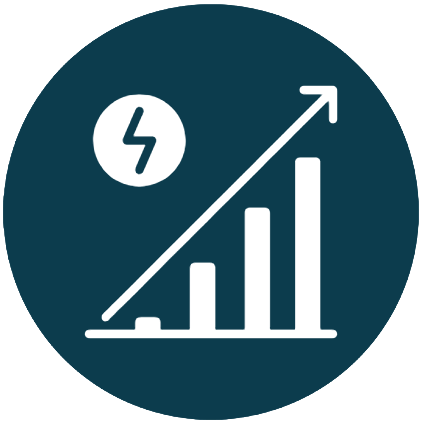Economical, sustainable and risk-free
The easy way to LED conversion

Conventional fluorescent tubes have been banned since 2023. Modern, energy-efficient LED lighting such as the GLT LED TUBE is not only required by law, but above all makes economic sense: lighting accounts for up to 40% of electricity consumption in companies.
With a standard-compliant conversion according to IEC EN 62776, you ensure the CE conformity of your system, permanently reduce energy and maintenance costs and meet current ESG and sustainability requirements.
Your LED conversion is so easy


Analyse your need

Calculate savings

Choice of assembly

ESG-Conformity
LED lighting installed easily and safely
The GLT LED TUBE is quick, easy, and safe to install. For fixtures with conventional ballasts, you can replace them yourself. For fixtures with electronic ballasts, the conversion must be performed by a specialist.
After the conversion, the lighting system can be operated without any electrical knowledge, and you'll always have access to the latest LED technologies.
Learn more in the video (german speaking):
How do I swap to the GLT LED TUBE with a conventional ballast (CCG)?
For fixtures with a conventional ballast, replace the starter with a dummy. Then install the GLT LED TUBE in place of the old fluorescent tube.

How do I swap to the GLT LED TUBE with an electronic ballast (ECG)?
The installation of a GLT LED TUBE into an electronic ballast fitting must be performed by a specialist. Thanks to the GLT LED TUBE's direct power supply, the disruptive ballast is eliminated, increasing operational reliability.
Certified GLT installation partners: Professional installation for optimal lighting solutions
A lighting system is only as good as its installation. Thanks to our many years of experience, we rely on qualified installation partners from German LED Tech, who ensure professional and reliable installation.
We take the time to provide comprehensive consultation and precise measurement services beforehand. This ensures that your lighting solution is not only energy-efficient, but also technically sound and visually appealing.
Our certified GLT installation partners are listed below:
References: LED lighting from GLT in use at leading companies
Our LED products are already being successfully deployed by renowned customers – from industrial and logistics halls to retail stores and parking garages, as well as infrastructure and administrative buildings. They ensure efficient lighting, lower operating costs, and maximum reliability – tested and proven in daily use.
Efficiency and ecology verified by Fraunhofer IBP
Old lighting banned – convert to LED now in compliance with the law
Since 2023, many fluorescent tubes have been banned under EU regulations. We'll show you the easy way to convert to LEDs in compliance with standards – efficient, sustainable, and without interrupting operations.
Request a non-binding consultationRequest a non-binding consultation
Are you planning a conversion? We'll get back to you within 24 hours.
Get free consultation and a non-binding offer for your LED project.
Here you will find everything you need to know about retrofitting to LED lighting from German LED Tech.
Why is retrofitting to LED lighting especially important now?
Since 2023, fluorescent tubes have been banned under EU regulation. To ensure the CE conformity of existing lighting systems, it is essential to retrofit as quickly as possible.
High energy and maintenance costs pose a major challenge for companies, as lighting can account for up to 40% of electricity consumption. Retrofitting to LED significantly reduces energy use and supports compliance with ESG and sustainability requirements.
Are there subsidy programs for retrofitting to LED?
Yes, both at federal and state level there are funding programs such as the Federal Funding for Efficient Buildings (BEG) and the Municipal Guideline of the National Climate Protection Initiative (NKI). These provide grants of up to 40% for the retrofit to LED lighting.
How does the GLT rental model for LED lighting work?
The GLT rental model enables companies to implement modern LED lighting systems without incurring high upfront costs. Instead, you pay regular installments that are tax-deductible as operating expenses. This preserves liquidity and provides financial flexibility.
Can existing luminaires and fixtures be reused?
Yes, existing standardized luminaires with G8/G13 sockets can be retrofitted with our GLT TUBES. This saves costs and reduces installation effort.
How does the retrofit to LED work?
The process includes a needs analysis, calculation of the savings potential, clarification of rental and funding models, the actual retrofit, and finally the take-back of old luminaires. We guide you through every step.
How can I determine which GLT TUBES are suitable replacements for my fluorescent tubes?
Standardized lengths
fluorescent tubes vs. GLT LED TUBEs
The lengths are standardized for straight fluorescent tubes (length without contact pins). GLT LED TUBE for LED retrofit according to IEC/EN62776.
Is retrofitting possible during ongoing operations?
Yes, our certified installation partners carry out the retrofit without disrupting ongoing operations. This minimizes downtime and ensures a smooth transition.
Can I retrofit to LED myself?
Yes, for luminaires and fixtures with conventional ballasts (CCG) you can carry out the replacement quickly and easily. For luminaires with electronic ballasts (ECG), an electrician is required once for the retrofit; afterwards, you can operate the lighting system yourself without electrical expertise.
How does retrofitting contribute to sustainability?
LED lighting significantly reduces energy consumption and thus CO₂ emissions. The unique environmental performance of our GLT TUBE is verified by an EPD according to ISO 14025 and EN 15804. German LED Tech supports a circular economy through the take-back and refurbishment of LED lighting products.
The goal of retrofit is also to preserve and upgrade as much of the existing standardized lighting infrastructure as possible. Only defective luminaires and trunking rails are replaced. This way, valuable assets are retained and the amount of electronic waste is reduced.








